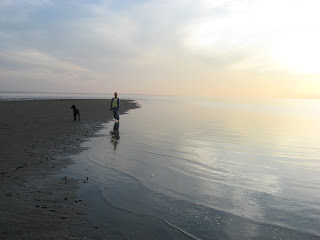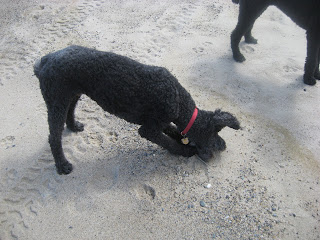Favorite Walks
1. Bayside beaches at low tide2. Truro's Pamet Trail, through coastal heath and then through dunes to the breakers
Songs that ran through my head for the whole month
1. Over The Mountain, Across the Sea, 1957 doo-wop hit by Johnnie and Joe http://www.youtube.com/watch?v=sDpzLIeCYSc&feature=fvwrel
2. Not Fade Away by the Rolling Stones http://www.youtube.com/watch?v=pt_zum97kjE
Things I learned
1. Not to spend a couple of hours in a structure this height and then stand up quickly when it's time to leave.
2. That each day at low tide, dozens of seals congregate on a sandbar off High Head Road in Truro.
3. All about oak apples. Who knew? Here's a row of them, in various stages of dessication.
My theory: that the larva of the wasp that lives inside it will feast on its oaky substance until it's time to hatch next spring. Is that what happens? What we do know for sure is that when that larva develops into a wasp, it too will lay an egg on the axil of an oak leaf , thus compelling the tree to produce this apple-like growth.
4. About the existence of this plant, artemisia campestris, a silvery sand dune beauty:
Things I Cooked
1. Shrimp Piccatahttp://www.bhg.com/recipe/seafood/shrimp-piccata/
2. Turkey-Vegetable Chili. The recipe is pasted at the end of this blog post.
3. Spaghetti with Swordfish in Tomato sauce with Fennel
http://www.epicurious.com/recipes/member/views/SPAGHETTI-WITH-SWORDFISH-IN-TOMATO-SAUCE-WITH-FENNEL-1228459
4. French Potato and Green Bean Salad
http://www.nytimes.com/recipes/12564/French-Potato-and-Green-Bean-Salad.html
5. Sarah P's Vegetarian Chili
If you want the recipe, let me know
Audiobooks I Heard
- Out Stealing Horses by Per Petterson
- I Curse the River of Time by Per Petterson
- Tinkers by Paul Harding
- This Boy's Life by Tobias Woolf
- Hare with the Amber Eyes by Edmund DeWaal
- Wild by Cheryl Strayed
- Gilead by Marilynne Robinson
Things I Made
1. This felted image of Penwood State Park in fall
2. This painted and embroidered image of a path atop the dune high over the beaches of Eastham and Wellfleet
3. This knitted blanket. It will be complete when it reaches 30 inches. Until then, well, it will just inch along:
Times I Left the Cape for Home and Beyond
- Once to West Hartford for the birthday party of my dear friend Margie
- Once to New York City to watch my daughter, Julia, installed as assistant cantor at Central Synagogue in Manhattan http://www.centralsynagogue.org/index.php/about_central/our_clergy/katz/
Tomorrow I leave the Cape for what may be months. But I collected sand, shells, and dried seaweed yesterday, and I hope to make them into a sandy Cape collage. And I'm going to be processing the experiences of this September visit all through the coming winter months, drawing them through me and around me like, well, a cape.
TURKEY AND VEGETABLE CHILI GRASSO
I pound ground turkey
2 tablespoons olive oil
1 eggplant, chopped (about
4 cups)
1green bell pepper, chopped
1 large onion, chopped
2 celery ribs, chopped
a 16-ounce can kidney beans,
drained and rinsed
a 16-ounce can black beans,
drained and rinsed
an 8-ounce can prepared tomato
sauce
2 cups chicken broth
71teaspoon cayenne
171teaspoons chili powder
2 garlic cloves, minced
fresh lime juice to taste '
~ cup chopped fresh coriander,
or to taste
Accompaniment: cooked brown
rice
In a large skillet cook turkey in oil over moderately high heat, stirring to break up lumps, until browned, about 8 minutes. Stir in vegetables, beans, tomato sauce, broth, spices, and garlic and
simmer, covered, stirring occasionally, 30 minutes. Stir in lime juice and coriander and season chili with salt and pepper. Cool chili, uncovered, and keep covered and chilled 2 days or frozen 1 month.
Serve chili with brown rice. Serves 6.
KATHERlNEGRASSO
PARK RIDGE,NEW JERSEY














